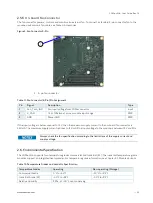
COMe-cEL6 - User Guide, Rev.1.3
// 40
3.7.
LPC
The Low Pin Count (LPC) interface is pin shared with eSPI. The LPC interface is the default connection to the COMe
connector. The module’s signal ESPI_EN# (pinB47) indicates whether ESPI-mode or LPC-mode is enabled/disabled.
In LPC mode “ESPI_EN#” is unconnected on the carrier. The module uses pull-up resistors on this signal to detect the
mode.
If ESPI_EN# selection on the carrier does not match the module configuration (eSPI/LPC) the
module is unable to boot.
The LPC low speed interface can be used for peripheral circuits such as an external Super I/O controller that typically
combines legacy-device support into a single IC. The implementation of this subsystem complies with the COM
Express® Specification. For more information, refer to the COM Express® Design Guide maintained by PICMG or the
official PICMG documentation.
The LPC bus does not support DMA (Direct Memory Access). When more than one device is used on LPC, a zero delay
clock buffer is required that can lead to limitations for the ISA bus.
For LPC Super I/O, additional BIOS implementations are necessary, contact Kontron Support.
3.8.
Intel® PSE
The Intel® Programmable Service Engine (PSE) is a dedicated offload engine for IoT functions such as embedded
controller, low DMIP computing, network proxy, out-of-band device management, network proxy, real-time and
sensor hub.
The COMe-cEL6 supports Intel® PSE. For more information, see Table 5: Processor Specification
3.9.
Intel® TCC
Intel® Time Coordinate Computing) (TCC) improves the time synchronization performance and the timeless (also
known as real-time) performance by providing a common time keeping framework making it possible for software to
calculate the precise time between numerous systems.
The COMe-CEL6 supports Intel® TCC on industrial grade modules. For more information, see Table 5: Processor
Specification.
3.10.
Real Time Clock (RTC)
The RTC keeps track of the current time accurately. The RTC’s low power consumption enables the RTC to continue
operation and keep time using a lower secondary source of power while the primary source of power is switched off
or unavailable.
The RTC’s battery voltage range is 2.8 V to 3.47 V. Typical RTC values are 3 V and less than 10 μA. If the module is
powered by mains supply, the RTC voltage is generated by on-module regulators, to reduce RTC current draw.
The COMe-cEL6 supports an internal RTC by default with the option for an external RTC on request.
Using the COMe-cEL6 without RTC battery voltage supply may result in improper behavior.
Contact Kontron Support in case you plan a carrier design without RTC battery.















































